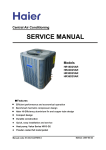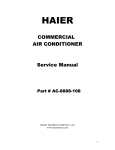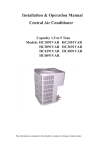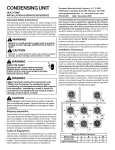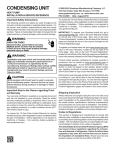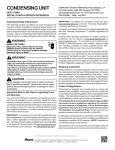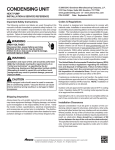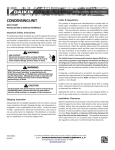Download Haier HR18D2VAR User's Manual
Transcript
13 SEER 1.5 to 3.0 Ton HR18D2VAR HR24D2VAR HR30D2VAR HR36D2VAR No.0010578573 ! WARNING These instructions are intended as an aid to qualified, licensed service personnel for proper installation, adjustment and operation of this unit. Read these instructions thoroughly before attempting installation or operation. Failure to follow these instructions may result in improper installation, adjustment, service or maintenance possibly resulting in fire, electrical shock, property damage, personal injury or death. This product is designed and manufactured to permit installation in accordance with National Codes. It is the installer's responsibility to install the product in accordance with National Codes and/or prevailing local codes and regulations. The manufacturer assumes no responsibility for equipment installed in violation of any codes or regulations. The United States Environmental Protection Agency (EPA) has issued various regulations regarding the introduction and disposal of refrigerants in this unit. Failure to follow these regulations may harm the environment and can lead to the imposition of substantial fines. Because these regulations may vary due to the passage of new laws we suggest that any work on this unit be done by a certified technician. Should you have any questions please contact the local EPA office. The manufacturer's warranty does not cover any damage or defect to the air conditioner caused by the attachment or use of any components, accessories or devices (other than those authorized by the manufacturer) into, onto, or in conjunction with the air conditioner. You should be aware that the use of unauthorized components, accessories or devices may adversely affect the operation of the air conditioner and may also endanger life and property. The manufacturer disclaims any responsibility for such loss or injury resulting from the use of such unauthorized components, accessories or devices. Attach the service panel to the outdoor unit securely. If the service panel is not attached securely, it could result in a fire or an electric shock due to dust, water, etc. These instructions are intended as an aid to qualified, licensed service personnel for proper installation, adjustment and operation of this unit. Read these instructions thoroughly before attempting installation or operation. Failure to follow these instructions may result in improper installation, adjustment, service or maintenance possibly resulting in fire, electrical shock, property damage, personal injury or death. This product is designed and manufactured to permit installation in accordance with National Codes. It is the installer's responsibility to install the product in accordance with National Codes and/or prevailing local codes and regulations. The manufacturer assumes no responsibility for equipment installed in violation of any codes or regulations. The following information should be read carefully prior to installing units with scroll compressors. 1.PUMP DOWN PROCEDURE CAUTION: Scroll compressors should never be used to evacuate the air conditioning system. Vacuums this low can cause internal electrical arcing resulting in a damaged or failed compressor. 2.CRANKCASE HEATER Scroll equipped units do not have or do not require a crankcase heater. 3.TIME DELAY COMPONENT The time delay is located in the low voltage control circuit. When the compressor shuts off due to thermostat operation or a power failure, this components keeps the compressor off for at least 30 seconds which allows the system pressure to equalize. 4.UNBRAZING SYSTEM COMPONENTS If the refrigerant charge is removed from a scroll equipped unit by bleeding the high side only, it is sometimes possible for the scrolls to seal, preventing pressure equalization through the compressor. This may leave the low side shell and suction line tubing pressurized. If a brazing torch is then applied to the low side while the low side shell and suction line contains pressure, the pressurized refrigerant and oil mixture could ignite when it escapes and contacts the brazing flame. To prevent this occurrence, it is important to check both the high and low side with manifold gauge before unbrazing, or in the case of repairing a unit on an assembly line, bleed refrigerant from both the high and low side. Message to Owner These instructions should be carefully read and kept near the product for future reference. While the instructions are addressed primarily to the installer, useful maintenance information is included. Have your installer acquaint you with the operating characteristics of the product and periodic maintenance requirements. TABLE OF CONTENT 1.Introduction --------------------------------------------------------------------------------------- 1 2.Nomenclature for Model Number ------------------------------------------------------------- 1 3.Specification ------------------------------------------------------------------------------------- 2 4.Unit Inspection ----------------------------------------------------------------------------------- 5 5.Equipment Protection From Environment -----------------------------------------------------5 6.Installation ---------------------------------------------------------------------------------------- 5 6.1. General --------------------------------------------------------------------------------------- 5 6.2.Unit clearances ------------------------------------------------------------------------------ 6 6.3.Refrigerant piping --------------------------------------------------------------------------- 6 6.4.Electrical wiring -----------------------------------------------------------------------------11 7.System Startup -----------------------------------------------------------------------------------12 8.Operation ---------------------------------------------------------------------------------------- 13 9.Miscellaneous ----------------------------------------------------------------------------------- 13 9.1.Replacement parts -------------------------------------------------------------------------- 13 9.2.Troubleshooting guide --------------------------------------------------------------------- 13 9.3.Wiring diagram ----------------------------------------------------------------------------- 13 1.INTRODUCTION This manual contains the installation and operating instructions for your new Heat Pump. Improper installation can result in unsatisfactory operation or dangerous conditions. Carefully read this manual and any instructions packaged with separate equipment required to make up the system prior to installation. Give this manual to the owner and explain its provisions. The owner should retain this manual for future reference. 2.NOMENCLATURE FOR MODEL NUMBER H R 24 D 2 V A R Brand symbol - H: Haier System type - C: Air conditioner; R: Heat pump. Nominal capacity in (000) Btu/h SEER designation. D=13, E=14 Design series. 2 - 2nd Generation Electric: V=208/230-1-60; C=208/230-3-60, D=460-3-60, Y=575-3-60 Body style Reserved Example: HR24D2VAR 1 1000 Nominal RPM 2 1075 3/8"[9.52] 1000 3/8"[9.52] [682* 682*725] 189[86] 205[93] [682*682*725] 172[78] 187[85] 183[83] 26 7/8"*26 7/8"*28 1/2" 26 7/8"*26 7/8"*28 1/2" 26 7/8 "*26 7/8"* 28 1/ 2" Approx Shipping Weight - Lbs (kg) [ 616 *616*683] [616 *616*683] [616*616*683] 141.34[4000] 24 1/4"*24 1/4"*26 7/8" Net Weight - Lbs (kg) W*D*H 1/4 1/8 3/4"[19.05] 1.4 0.86 3/4"[19.05] 107.77[3050] 61 53.5 10.1 25 20 8.0 14.0 197 - 253 208/230 60Hz 1PH HR30D2VAR 10.9 HR24D2VAR 24 1/4"*24 1/4"*26 7/8" 24 1/4"*24 1/4"*26 7/8 " 3/4"[19.05] 104.24[2950] [682*682*725 ] 16 7 [7 6 ] Shipping Dimensions - In (mm) W*D*H Net Dimensions - In (mm) R-22 Charge -Oz (g) Vapor Line OD - In (mm) 3/8"[9.52] 1/8 0.86 Full Load Amps Rated HP 36 5.4 15 7.6 HR18D2VAR A mp s Locked Running Liquid Line OD - In (mm) Fan Motor Compressor Rated Load Amps (HACR per NEC ) Max Fuse or Max CKT. BKR. Unit Supply Voltage Normal Voltage Range Minimum Circuit Amps MODEL: 207[94] 222[101] 26 7/8"*26 7/8"*32" [682*682*813] 24 1/4"*24 1/4"*30 3/8" [616*616*771] 7/8"[22.2] 148.41[4200] 3/8"[9.52] 1.6 1/3 1120 78 30 11.8 16.4 HR36D2VAR 3.SPECIFICATION The dimensions for the condensing unit are illustrated in Figure 1. Physical and electrical specifications are provided in Table 1 for 13 SEER systems respectively. The Figure 2 show a schematic of a heat pump on the cooling cycle and the heating cycle. Table 1: Model:HR18-36D2VAR 24 D W H Figure 1 Table 2: System Capacity cooling Outdoor Indoor Indoor fan speed ARI data of indoor Cooling Capacity with different outdoor temperature Capacity SEER CFM 80 85 90 95 100 105 110 115 17237 16490 16712 15980 21825 21488 21150 HR18D2VAR HB2400VD1M20 M 17000 13 670 19210 19197 18020 17000 HR24D2VAR HB2400VD1M20 H 22500 13 900 25425 24683 23850 22500 22162.5 HR30D2VAR HB3600VD1M22 L 28000 13 1125 31640 30716 29680 28000 27580 27160 26740 26320 HR36D2VAR HB3600VD1M22 H 35000 13 1240 39550 38395 37100 35000 34475 33950 33425 32900 heating Outdoor Indoor Indoor fan speed ARI data of indoor Heating Capacity with different outdoor temperature Capacity HSPF CFM -10 0 670 4773 6418 8036 900 6364 8558 10715 12909 15030 17685 20836 24000 7.8 1125 8273 11125 13930 16782 19539 22990 27087 31200 7.8 1240 10341 13906 17412 20977 24424 28738 33859 39000 HR18D2VAR HB2400VD1M20 M 15000 7.8 HR24D2VAR HB2400VD1M20 H 20000 7.8 HR30D2VAR HB3600VD1M22 L 26000 HR36D2VAR HB3600VD1M22 H 32500 3 10 20 30 40 9682 11272.73 13264 50 60 15627 18000 Heat Pump Refrigerant Circuit Figure 2 Cooling DISCHARGE TEMP. SENSOR SERVICE PORT SERVICE VALVE REVERSING VALVE HIGH PRESSURE LOW PRESSURE ACCUMULATOR SERVICE PORT SERVICE PORT DEFROSED SENSOR CHECK VALVE ORIFICE DRIER(optional) INDOOR COIL DISTRIBUTOR Heating CHECK VALVE ORIFICE SERVICE VALVE SERVICE PORT SERVICE VALVE CONDENSER EVAPORATOR COMPRESSOR OUTDOOR COIL DISTRIBUTOR DISCHARGE TEMP. SENSOR REVERSING VALVE HIGH PRESSURE SWITCH LOW PRESSURE ACCUMULATOR INDOOR COIL SERVICE PORT SERVICE PORT DEFROSED SENSOR EVAPORATOR CONDENSER COMPRESSOR OUTDOOR COIL CHECK VALVE ORIFICE CHECK VALVE ORIFICE DRIER(optional) DISTRIBUTOR SERVICE VALVE DISTRIBUTOR !Warning - The Bi-flow drier is strongly recommended to be installed by installer and replaced once two years. This will give your equipment great help in long life. 4 4.UNIT INSPECTION This product has been inspected at the factory and released to the transportation agency without known damage. Inspect exterior of carton for evidence of rough handling in shipment. Unpack carefully. If damage is found, report immediately to the transportation agency. 5.EQUIPMENT PROTECTION FROM ENVIRONMENT The metal parts of the unit may be subject to rust or corrosion in adverse environmental conditions. This oxidation could shorten the unit life. Salt spray or mist in seacoast areas, sulphur or chlorine from lawn watering systems and various chemical contaminants from industries such as paper mills and petroleum refineries are especially corrosive. If the unit is to be installed in an area where contaminants are likely to be a problem, special attention should be given to the equipment location and exposure. Avoid having lawn sprinkler heads spray directly on the unit cabinet. In coastal areas, locate the unit on the side of the building away from the waterfront. Shielding provided by fence or shrubs may give some protection. Regular maintenance will reduce the buildup of contaminants and help to protect the unit's finish. ! WARNING - Disconnect all electrical power to the unit before servicing. Disconnect power to both the indoor and outdoor units. NOTE: There may be more than one electrical disconnect switch. Failure to shut off power can cause electrical shock resulting in personal injury or death. Frequent washing of the cabinet, fan blade and coil with fresh water. Regular cleaning and waxing of the cabinet with good automobile polish. A good liquid cleaner may be used several times a year to remove matter that will not wash off with water. The best protection is frequent cleaning, maintenance and minimal exposure to contaminants. 6.INSTALLATION 6.1.GENERAL These units are designed for outdoor installations. They can be mounted on a slab or rooftop. It is important to consult your local code authorities at the time the first installation is made. Check following points before attempting any installation: Structural strength of supporting members. Clearances and provision for servicing. Power supply and wiring. Location for minimum noise, where operating sounds will not disturb owner or neighbors. Location where there is no risk of combustible gas leakage. Location where external water drainage cannot collect around the unit. Location where roof runoff water does not pour directly on the unit. Provide gutter or other shielding at roof level. Don't locate unit in an area where excessive snow drifting may occur or accumulate. 5 Provide a level concrete slab. To prevent transmission of noise or vibration, slab should not be connected to building structure. Some sort of sound-absorbing material should be placed between the condenser and the slab. A good material to use is rubber and cork pad. For rooftop application, make sure the building construction can support the weight and that proper consideration is given to the weather-tight integrity of the roof. The condensing unit contains moving parts and can vibrate. Therefore, sound is also a consideration in rooftop applications. ! WARNING - Install the unit securely in a place that can bear the weight of the unit. When installed in an insufficiently strong place, the unit could fall causing injury. 6.2.UNIT CLEARANCES 10" Min. 10" Min. Service Access 18" Min. Service Access 18" Min. 10" 10" Figure 3 The minimum clearances for the unit are illustrated in Figure 3. Condenser air enters from three sides. Air discharges upward from the top of the unit. Refrigerant tube and electrical connections are made from the service access area. The most common application will find the unit best located about 10" from back wall with connection side facing the wall. This application minimizes exposed tubing and wiring, minimizing the space for youngsters to run around the unit with subsequent damage to the tubing or wiring. In more confined application spaces, such as corners provide a minimum of 10" clearance on all air inlet sides. For service access to the compressor and control box, allow 18" minimum clearance. Ensure top is unobstructed. If units are to be located under an overhang, there should be a minimum of 36" clearance and provision made to deflect the warm discharge air out from the overhang. In order to have an unrestricted air flow, owners should be advised to avoid lawn mower discharge toward the unit depositing debris on the fin coil surface reducing the unit efficiency. 6.3.REFRIGERANT PIPING The refrigerant piping is very important as it affects the proper operation and efficiency of the air conditioning system. Note the following guidelines: 6 OUTDOOR UNIT ADDITIONAL SUCTION LINE OIL TRAP FOR EACH 20 FOOT RISE OF PIPE PITCH SUCTION LINE TOWARD OUTDOOR UNIT 1/2" FRO EVERY 10' OF LINE INDOOR UNIT ABOVE OR LEVEL TO OUTDOOR UNIT OUTDOOR UNIT LIQUID LINE 70' LIQUID LINE MAX. SUCTION LINE OIL TRAP WHEN INDOOR UNIT IS 4 FEET OR MORE BELOW OUTDOOR UNIT INDOOR UNIT A INDOOR UNIT BELOW OUTDOOR UNIT 6' B-1 INVERTED LOOP LIQUID LINE INDOOR UNIT INDOOR UNIT 50' MAX. OUTDOOR UNIT SUCTION LINE B-2 Figure 4 Only refrigeration-grade copper piping (dehydrated and sealed) should be used. Take extreme care to keep the refrigerant tubing clean and dry prior to and during installation. If in doubt, blow out the tubing with dry nitrogen to remove any chips or debris before connection. Always keep tubing sealed until it is in place and the connections are to be made. Refrigerant piping should be as short as possible, with a minimum of elbows or bends, to avoid capacity loss and increased operating costs. Refrigerant lines must be adequately supported. If metal strapping is used to secure the tubing, do not allow the strapping to directly contact the tubing. Use a closed cell insulation to separate the strapping from the tubing. Do not kink or twist the tubing. Refrigerant piping should not be installed in a cement slab, as this limits access to the refrigerant should a leak be suspected. To ensure good oil return to the compressor, it is important to pitch the horizontal suction line toward the compressor, approximately 1/2" for every 10' of line. Line Insulation Suction line requires insulation in order to prevent condensation from forming on the piping and to prevent heat gain caused by surrounding air. Generally 3/8" wall thickness of Armflex or equivalent is satisfactory. In severe application (hot, high humidity areas) greater thickness may be required. Apply the line insulation by sliding it on the sealed tuing before cutting and making connections. Liquid line does not necessarily need insulation, however, if they are exposed to high ambient temperatures (i.e. kitchen, boiler rooms, hot attics & rooftop surface), then, they should be insulated. Make sure to use the proper size tubing for the liquid line to prevent liquid refrigerant flashing to a vapor within the liquid line. Do not allow the vapor line and liquid line to touch together. This would cause an undesirable heat transfer resulting in capacity loss and increased power consumption. 7 Refrigerant Line Sizing Check the following table (Table 3) for correct suction and liquid line sizes for any combination of the unit size and the maximum refrigerant line length. Unit Size (Ton) Refrigerant Line Length (Ft) 0 - 24 25 - 49 50 - 74 Line Outside Diameter (In) Suction Liquid Suction Liquid Suction Liquid SEER 1.5 3/4 3/8 3/4 3/8 7/8 1/2 13 2.0 2.5 3/4 3/4 3/8 3/8 3/4 3/4 3/8 3/8 7/8 7/8 1/2 1/2 13 13 3.0 7/8 3/8 1 3/8 1 1/2 13 1/8 1/8 Table 3:Refrigerant Line Sizing The factory charge is sufficient for 25 feet of standard liquid line. For longer or shorter liquid line lengths, adjust the charge as follows: 1/4" Line +/- 0.3 oz. Per foot 5/16" Line +/- 0.4 oz. Per foot 3/8" Line +/- 0.6 oz. Per foot 1/2" Line +/- 1.2 oz. Per foot. Vertical Separation between Indoor and Outdoor Units Maximum allowable vertical separations between indoor and outdoor units are illustrated in Figure 4-A and Figure 4-B. It's 70' when the indoor unit is below the outdoor unit (Figure 4-A), and 50' when the indoor unit is above the outdoor unit (Figure 4-B). To ensure good oil return to the compressor when the indoor unit is below the outdoor unit, suction line oil trap should be used as illustrated in Figure 4-A. Tubing Connections ! CAUTION - Use extreme caution in removing the caps from the suction and liquid line fittings, as there is pressure present. A fitting is on the liquid line to remove pressure. ! CAUTION - Heat Pumps are charged with refrigerant. Heat Pump liquid and suction valves are closed to contain the charge within the unit. Do not force the valve stem against the retaining ring. If the valve stem is backed out past the retaining ring, system pressure could force the valve stem out of the valve body and possibly cause personal injury. ! CAUTION - The piston is in the accessory bag. Don't forget to take it out and put into the indoor liquid pipe orifice. Instructions on the field tubing connections and valve opening procedure are as follow: 8 1.Tubing should be cut square. Make sure it is round and free of burrs at the connecting ends. Clean the tubing to prevent contamination from entering the system. 2.Make sure that both refrigerant stop valves at the outdoor unit are closed. 3.Push the tubing into the fitting until it stops. This prevents flux from getting into the system. 4.Remove the cap and Schrader valve core from the service port to protect the valve seals. 5.Wrap a wet rag around the valve stub before brazing. 6.Braze the joints of interconnecting tubing. Flow dry nitrogen into the shutoff valve port and through the tubing while brazing. 7.After brazing quench with a wet rag to cool the joint. Reinstall the Schrader core in the valve, if removed for brazing. 8.Pressurize the lines to 150 psi maximum with dry nitrogen. Check for leaks at all joints with liquid detergent. If a leak is found, repair it after removing the nitrogen. Repeat the process and re-ckeck. 9.Do not purge the lines with refrigerant. Evacuate the lines and indoor coil. Refrigerant Metering Devices Replace the existing indoor unit fixed orifice with the orifice supplied with the outdoor unit. See table 4 for the fixed orifice size for each unit. Table 4 Fixed orifice size outdoor model indoor model orifice size HR18D2VAR HB2400VD1M20 057 HR24D2VAR HB2400VD1M20 065 HR30D2VAR HB3600VD1M22 071 HR36D2VAR HB3600VD1M22 078 9 Evacuation All new installations must be evacuated to a deep vacuum in order that all noncondensible gases and moisture are removed prior to charging the system. Air in a system causes high condensing pressure, which increases power consumption and reduces performance. The presence of moisture in a system can render it inoperable in a very short time. Proper evacuation assures a dry, uncontaminated system. Here is the recommended evacuation procedure: 1.Connect vacuum pump to both liquid and suction valve service ports. 2.Evacuate the interconnecting tubing and indoor coil to 500 microns or less for a minimum of 30 minutes. Close the valve to the vacuum pump and wait 15 minutes. Vacuum should not rise above 800 microns. If unable to obtain 500 microns, or vacuum rises above 800 microns over 15 minutes period, discontinue evacuation, pressurize and check for leaks. Repair any leaks found and repeat the step 2. 3.Close valve to the vacuum pump and stop pump. 4.When sure of a tight, well evacuated system, charge with refrigerant. Charging the System (For systems with capillary tube or fixed orifice metering device) Before checking the system charge, make sure that the outdoor unit and indoor coil must be an approved match per the unit specification. The indoor conditions should be within 2 F of the desired comfort conditions. ! WARNING - Do not vent refrigerant to the atmosphere! It is a violation of federal law to do so. If the refrigerant needs to be removed from a system to correct the charge inside, always use a recovery or recycling device. ! WARNING - To prevent personal injury, wear safety glasses and gloves when handling refrigerant. 10 5 5 The condensing unit rating plate and the tables of "Physical and Electrical Specifications / Outdoor Units" (Table 1) provide pertinent data necessary for the selection of proper size electrical service and over-current protection devices. Table 6 provides data on the minimum copper wire size as a function of supply wire length and circuit ampacity. Copper Wire Size - AWG (1% Voltage Drop) Supply Circuit Supply Wire Length - Ft Ampacity 50 100 150 200 15 14 10 8 6 20 12 8 6 4 25 10 8 6 4 30 10 6 4 4 35 8 6 4 3 40 8 6 4 2 45 6 4 3 2 50 6 4 3 1 Table 6: Minimum Wire Size Based on N.E.C. for 60 C Type Copper Conductors Below 100 Ampacity. The owner should be made familiar with the location of the over-current protection, the proper size for this application and the proper procedure for disconnecting power service to the unit. The condensing unit control wiring requires a 24 Volt minimum, 25 VA service from the indoor transformer as shown on the wiring diagram. 7.SYSTEM STARTUP 1.Turn thermostat to "OFF", turn on power supply at disconnect switch. 2.Turn temperature setting as high as it will go. 3.Turn fan switch to "ON". Indoor blower should run. Be sure it is running in the right direction. 4.Turn fan switch to "AUTO". Turn system switch to "COOL" and turn temperature setting below room temperature. Unit should run in cooling mode. 5.The compressor, indoor blower, and outdoor fan should now be running. Make sure cool air is supplied by the unit. 6.Turn the fan switch to the "Auto" position. The blower should stop 90 seconds later. 7.Turn system switch to "Heat" and fan switch to "Auto" . 8.Slowly raise the heating temperature setting. The compressor, indoor blower and outdoor fan should now be running. 9.If unit operates properly on the heating cycle, raise the heating temperature setting high enough. 10.For thermostats with emergency heat switch return to startup. 12 11.If checking the unit on the heating cycle in the wintertime, when the outdoor coil is cold enough to actuate the defrost control, observe at least one defrost cycle to make sure the unit defrosts properly. 12.Check the refrigerant charge (see Instructions under "Charging the System"). 13.Replace service port caps. Service port cores are for system access only and will leak if not tightly capped. 14.Check unit for tubing and sheet metal rattles. 15.Instruct the owner on operation and maintenance. Leave this "Installation and Operating Manual" and the "Use and Care Manual" with owner. 8.OPERATION Most single phase units are operated without start relay or start capacitor. Such systems should be off for a minimum of 5 minutes before restarting to allow equalization of pressures. The thermostat should not be moved to cycle unit without waiting 5 minutes. To do so may cause the compressor to stop on an automatic open overload device or blow a fuse. Poor electrical service can cause nuisance tripping in overloads or blow fuses. The compressor has an internal overload protector. Under some conditions, it can take up to 2 hours for this overload to reset. Make sure overload has had time to reset before condemning the compressor. 9.MISCELLANEOUS 9.1. Replacement Parts Contact your local distributor for a complete parts list. 9.2. Troubleshooting Guide Refer to the troubleshooting guide (Table 7) included in this manual.(P14) 9.3. Wiring Diagram Refer to the appropriate wiring diagram included in this manual.(P15) Table 7:Troubleshooting Guide ! WARNING - Disconnect all electrical power to the unit before servicing. Disconnect power to both the indoor and outdoor units. NOTE: There may be more than one electrical disconnect switch. Failure to shut off power can cause electrical shock resulting in personal injury or death. 13 Symptom Possible Cause Remedy Defective four way valve Check the valve coil or replace it Power off or loose electrical connection Incorrect thermostat setting No cooling/heating Defective contactor Open circuit breaker of blown fuses Defective transformer Interconnecting low voltage wiring damage Dirty filters Indoor air blockage Blocked outdoor coil Improperly sized unit Insufficient Cooling Improper airflow /Heating Incorrect refrigerant charge Air, non-condensibles or moisture in system Incorrect voltage Water on floor or in furnace Blocked condensate drain and "P" trap Run or start capacitor defective Loose connection Condenser fan runs, Compressor stuck, grounded or open compressor doesn't motor winding, open internal overload Low voltage condition Low voltage condition Incorrect voltage Compressor short-cycling Defective overload protector Refrigerant undercharge Register sweat Low evaporator airflow Restriction in liquid line, High head - Low metering device or filter drier vapor pressures Flowrator piston size too small Incorrect capillary tubes Blocked outdoor coil High head - High Refrigerant overcharge or normal vapor Condenser fan not running pressures Air, non-condensibles or moisture in system Low head - High Flowrator piston size too large vapor pressures Defective compressor valves Incorrect capillary tubes Low vapor - cool Low evaporator airflow compressor - iced Operating below 65 F outdoors evaporator coil Moisture in the system High vapor Excessive load pressure Defective compressor Fluctuating head Air or non-condensibles in system and vapor pressures Pulsing noise at Air or non-condensibles in system metering device or liquid line Make sure main switch is ON. Check and tighten all connections. Set thermostat correctly Check for 24V at contactor coil. Reset or replace Check wiring - Replace it. Replace thermostat wiring Clean & replace Check supply registers and return grills for blockage. Clear away leaves and other debris Recalculate load Check - should be 400CFM/Ton Charge correctly per instruction. Recover refrigerant, evacuate & recharge, add filter drier At compressor terminals, voltage must be within 10% of rating plate volts when unit is running. Remove blockage Replace Check and tighten all connections. Wait for 2 hours for overload to reset. Replace compressor if still open. At compressor terminals, voltage must be within 10% of rating plate volts when unit is running. Add start kit components At compressor terminals, voltage must be within 10% of rating plate volts when unit is running. Replace - check for correct voltage Add refrigerant Increase blower speed or reduce restriction - replace air filter Replace defective components Change to correct size piston Change coil assembly Clear away leaves and other debris Correct system charge Repair or replace Recover refrigerant, evacuate & recharge, add filter drier Change to correct size piston Replace compressor Replace coil assembly Increase blower speed or reduce restriction - replace air filter Add low ambient kit Recover refrigerant, evacuate & recharge, add filter drier Recheck load calculation Replace Recover refrigerant, evacuate & recharge. Recover refrigerant, evacuate & recharge 14 HR18-36D2VAR YL/GR 15 Made in P.R.C.


















